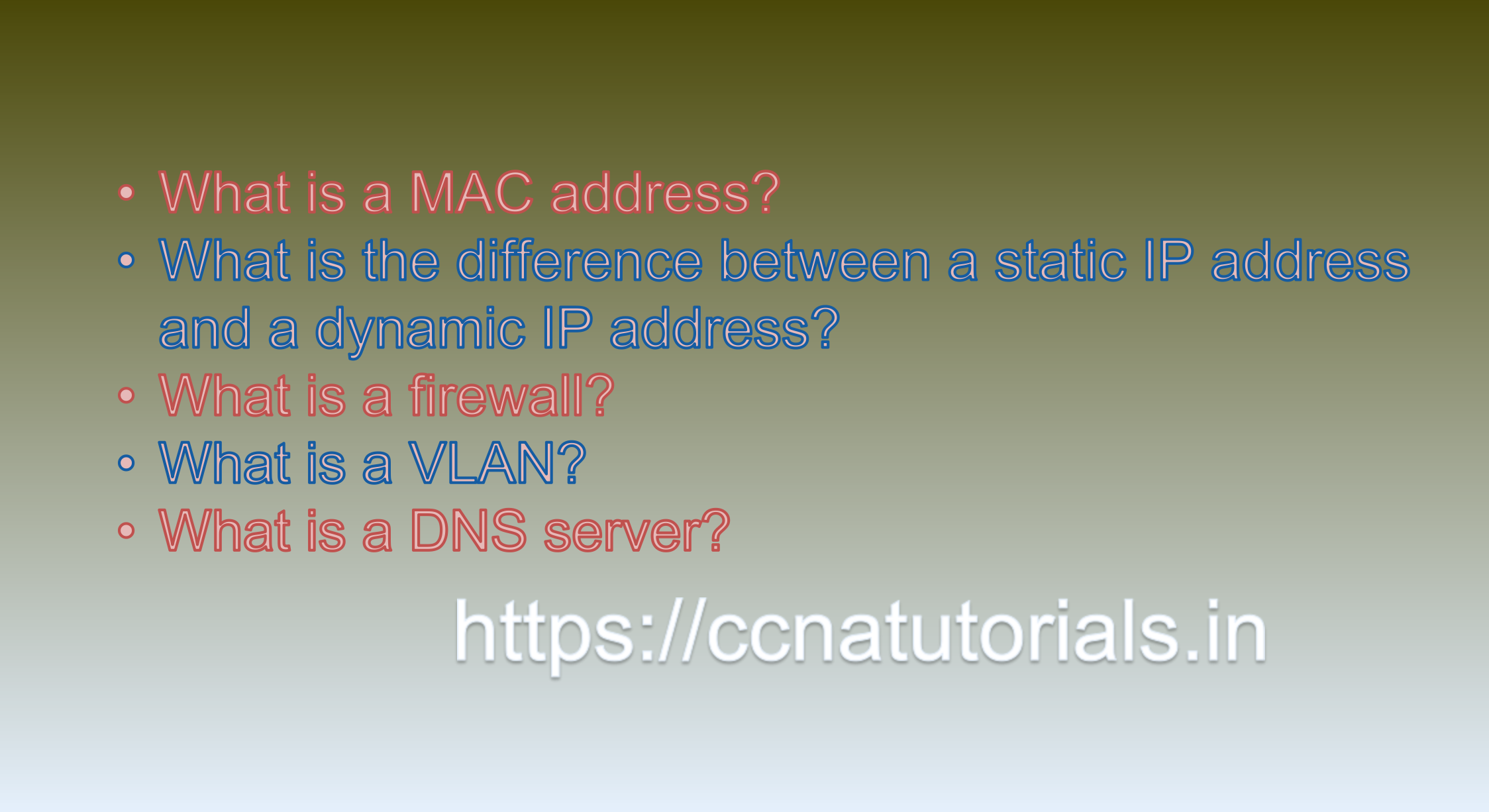Contents of this article
In this article, I describe some CCNA sample questions for practice before appearing in the CCNA 200-301 exam. The following questions are basic questions and related to the CCNA sample questions set 12. There are multiple sample questions set on this website for prior practice online. All questions are described with relevant answers. You can take the following questions and answer as reference for CCNA 200-301 exam. You may also need to do more practice with other websites and books to practice the CCNA sample questions set 12.
Question 1. What is a MAC address?
A MAC (Media Access Control) address is a unique identifier assigned to a network interface controller (NIC) for use as a network address in communications within a network. It is also referred to as a physical address or hardware address. The MAC address is a 48-bit (or 6-byte) identifier that is assigned to each NIC by the manufacturer. It is usually represented as a hexadecimal number and is used to identify devices on a network at the Data Link layer (layer 2) of the OSI model. MAC addresses are used in Ethernet and Wi-Fi networks to ensure that data is delivered to the correct device on the network.
When data is transmitted between devices, the MAC address of the destination device is included in the packet header, allowing switches and routers to forward the packet to the correct device. Because MAC addresses are unique and assigned by the manufacturer, they can be used to track and identify devices on a network. This can be useful for network management and troubleshooting, but can also raise privacy concerns if MAC addresses are used to track individual users without their consent. This is the answer to question 1 of CCNA sample questions set 12.
Question 2. What is the difference between a static IP address and a dynamic IP address?
A static IP address is a fixed IP address that is assigned to a device or a network and remains the same over time. It is typically manually configured by a network administrator or Internet Service Provider (ISP), and does not change unless it is manually reconfigured.
A dynamic IP address, on the other hand, is an IP address that is assigned to a device or network temporarily and may change over time. It is assigned automatically by a Dynamic Host Configuration Protocol (DHCP) server, which is typically part of the network infrastructure or provided by an ISP.
The main difference between static and dynamic IP addresses is that static addresses provide a fixed point of reference for network devices, while dynamic addresses are more flexible and can be reused as needed. Static IP addresses are typically used for servers, network infrastructure devices, and other devices that require a fixed IP address, while dynamic addresses are typically used for individual computers, smartphones, and other devices that do not require a fixed address.
There are pros and cons to both static and dynamic IP addresses. Static addresses provide a fixed point of reference for network devices, making it easier to manage network traffic and configure network devices. However, they may be more expensive to obtain and maintain, and may not be as flexible as dynamic addresses. Dynamic addresses are more flexible and can be used to support a larger number of devices, but they may be more difficult to manage and may require more frequent updates and reconfigurations. This is the answer to question 2 of CCNA sample questions set 12.
Question 3. What is a firewall?
A firewall is a network security system that monitors and controls incoming and outgoing network traffic based on a set of predetermined security rules. It acts as a barrier between a trusted, internal network and an untrusted, external network, such as the Internet.
Firewalls can be either hardware or software-based and are typically placed at the edge of a network to protect against unauthorized access and to prevent malware and other malicious traffic from entering the network. Firewalls accomplish this by analyzing incoming and outgoing network traffic and enforcing security policies based on that analysis.
Some common features of firewalls include:
- – Packet filtering: examining packets of data as they enter and leave a network and allowing or blocking them based on predetermined criteria.
- – Stateful inspection: analyzing packets of data to determine their state and allowing or blocking them based on their state.
- – Application-level filtering: examining the data within packets to determine whether specific types of traffic are allowed or blocked, such as email, web traffic, or file transfers.
- – Intrusion detection and prevention: detecting and preventing attacks from known and unknown sources.
Firewalls are an important component of network security and are used in a wide range of environments, from small home networks to large enterprise networks. They help protect against unauthorized access, data theft, and other security threats, and are an essential part of a comprehensive network security strategy. This is the answer to question 3 of CCNA sample questions set 12.

Question 4. What is a VLAN?
A VLAN (Virtual Local Area Network) is a logical grouping of devices within a local area network (LAN). It allows network administrators to segment a LAN into multiple virtual LANs, each with its own set of devices and network resources.
VLANs are typically used to improve network performance, security, and manageability. By creating separate VLANs for different types of devices or departments, network administrators can better manage network traffic and optimize network performance. VLANs also help improve network security by segregating sensitive network resources, such as servers and storage devices, from other parts of the network.
VLANs are implemented using network switches, which allow multiple VLANs to share the same physical network infrastructure. Each VLAN is identified by a unique VLAN ID, which is included in the header of each network packet. Switches use this VLAN ID to forward traffic to the appropriate VLAN.
Some of the benefits of VLANs include:
- – Improved network performance: By segmenting a LAN into multiple VLANs, network administrators can better manage network traffic and improve network performance.
- – Enhanced security: VLANs help improve network security by segregating sensitive network resources, such as servers and storage devices, from other parts of the network.
- – Greater flexibility: VLANs allow network administrators to add, remove, or modify network resources without having to reconfigure the entire network.
- – Simplified network management: VLANs allow network administrators to manage network resources more effectively by grouping them into logical VLANs.
VLANs are widely used in enterprise networks, data centers, and service provider networks to improve network performance, security, and manageability. This is the answer to question 4 of CCNA sample questions set 12.
Question 5. What is a DNS server?
A DNS (Domain Name System) server is a computer server that translates human-readable domain names, such as www.example.com, into machine-readable IP addresses, such as 192.0.2.1. This process is known as DNS resolution and is a critical part of the Internet’s infrastructure.
DNS servers store and maintain a database of domain names and their corresponding IP addresses. When a user enters a domain name into their web browser or other network application, the application sends a request to a DNS server to resolve the domain name into an IP address. The DNS server looks up the domain name in its database and returns the corresponding IP address to the application, which can then establish a connection with the appropriate server.
DNS servers can be either authoritative or recursive. Authoritative DNS servers are responsible for storing and distributing information about a specific domain name, such as the IP addresses of the servers that host the domain’s website and email. Recursive DNS servers, on the other hand, are responsible for resolving domain names for clients that do not have their own DNS server, such as individual computers and mobile devices.
DNS servers are critical to the operation of the Internet and play a key role in ensuring that network traffic is properly routed between servers and clients. Without DNS servers, users would need to remember and enter IP addresses directly into their applications, which would be difficult and error-prone. This is the answer to question 5 of CCNA sample questions set 12.
Conclusion for CCNA sample questions set 12
In this article, I described 5 questions with answers related to CCNA 200-301 exam. I hope you found these questions helpful for the practice of the CCNA 200-301 exam. You may drop a comment below or contact us for any queries related to the above questions and answers for CCNA 200-301. Share the above questions If you found them useful. Happy reading!!






